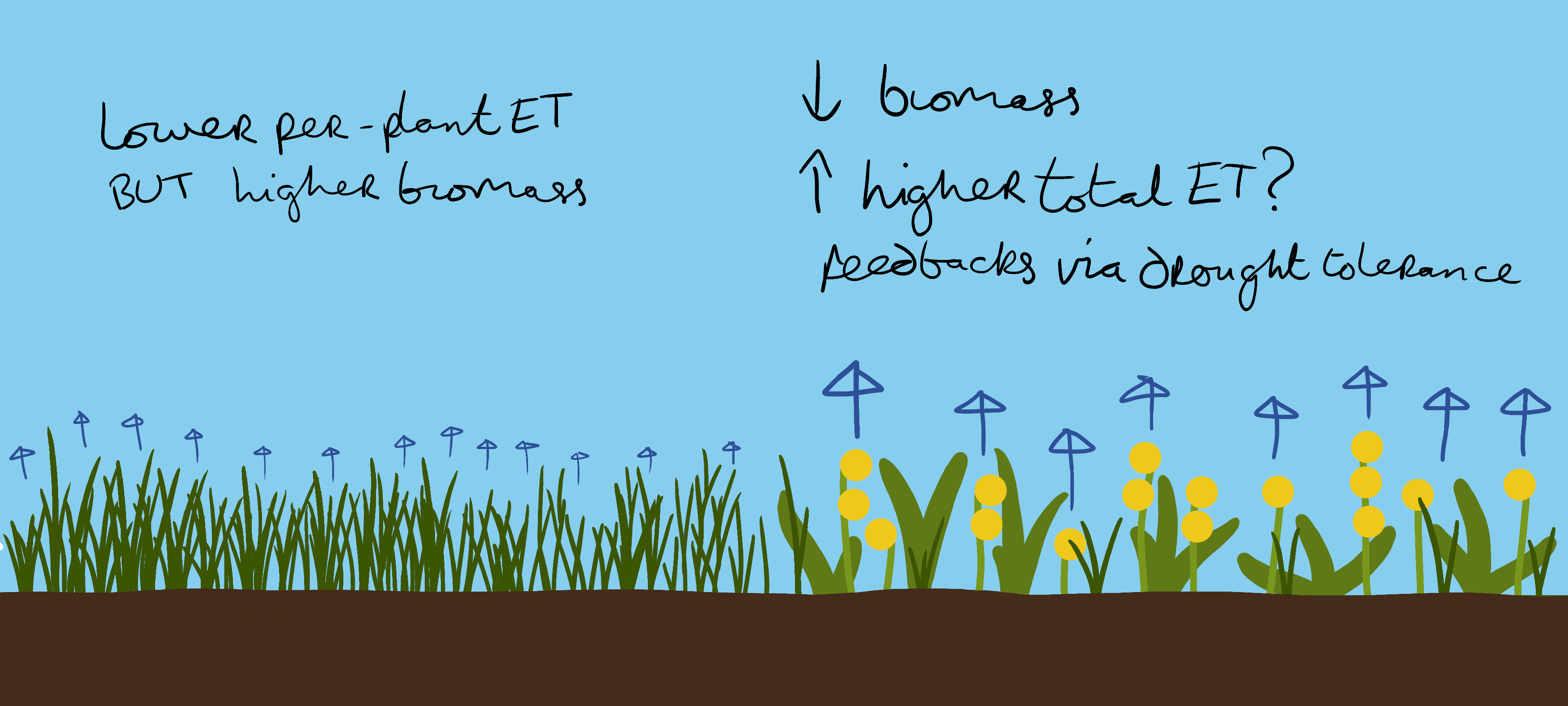7/10/2023 UPDATE: I have discovered other authors came up with this idea before me, as noted by Press and Phoenix¹¹. At least two authors have mentioned it: in the context of mistletoes¹²; and a North American root hemiparasite, Triphysaria¹³. However, as far as I can tell the hypothesis has never been tested.
“after establishing connections with suitable hosts, Triphysaria may harm other plant species without actually contacting them, essentially by acting as an aggressive, indirect competitor for soil water.”
Marvier, 1998, p. 2622¹³
The water relations of parasitic plants and their hosts are fairly well documented¹,². The effect of hemiparasites such as Rhinanthus (Yellow Rattle) on community structure³,⁴ and functional traits⁵ has also been studied. However, a factor that I believe has been overlooked is the interaction of these two phenomena: that hemiparasitic plants could have a significant effect on water availability in grassland communities, by increasing the amount of water lost via evapotransiration.
Rhinanthus maintains a significantly higher stomatal conductance than its hosts⁶. This creates a low water potential, so the parasite acts as a sink for xylem sap, drawing water and other resources in from the host root system, and potentially increasing the total amount of evapotranspiration relative to that from an unparasitised host. This could increase water loss from the soil. However, parasitism also reduces host growth, so the total amount of water taken up by the host is reduced⁶. Hence the effect of parasitism on total evapotranspiration is complex, and an increase won’t necessarily be the result. This is further complicated by water and nutrient availability, which also affect the interaction of Rhinanthus and its hosts⁷.
A second effect to consider is gaps in the sward which several authors have proposed the annual death of Rhinanthus creates in the sward⁸,⁹. This could potentially increase evaporation from the soil for part of the year, although this is less important than transpiration (outside of very dry grasslands with >370 mm of precipitation annually¹⁰), so this effect may be negligible.
I propose that high densities of Rhinanthus could have a significant effect on water availability in grasslands. Drought tolerant plants could be favoured both because they can withstand the water stress caused by parasitism directly, and also because Rhinanthus parasitism increases the total evapotranspiration of water from the ecosystem. This could be tested both by looking at whether drought-tolerance is favoured in grasslands with Rhinanthus, and direct measurement of evapotranspiration and soil moisture. A weighing lysimeter, which measures the change in weight of a soil column over time, could be used to compare the rate of water loss across swards with varying densities of Rhinanthus.
References
- Fahmy, Gamal Mohammad. 2013. ‘Ecophysiology of the Holoparasitic Angiosperm Cistanche Phelypaea (Orobanchaceae) in a Coastal Salt Marsh’. Turkish Journal of Botany 37: 908–19. https://doi.org/10.3906/bot-1210-48.
- Jiang, Fan, W. Dieter Jeschke, Wolfram Hartung, and Duncan D. Cameron. 2010. ‘Interactions Between Rhinanthus Minor and Its Hosts: A Review of Water, Mineral Nutrient and Hormone Flows and Exchanges in the Hemiparasitic Association’. Folia Geobotanica 45 (4): 369–85. https://doi.org/10.1007/S12224-010-9093-2/TABLES/1.
- Chaudron, Clémence, Monika Mazalová, Tomáš Kuras, Igor Malenovský, and Jan Mládek. 2021. ‘Introducing Ecosystem Engineers for Grassland Biodiversity Conservation: A Review of the Effects of Hemiparasitic Rhinanthus Species on Plant and Animal Communities at Multiple Trophic Levels’. Perspectives in Plant Ecology, Evolution and Systematics 52 (October). https://doi.org/10.1016/j.ppees.2021.125633.
- Heer, Nico, Fabian Klimmek, Christoph Zwahlen, Markus Fischer, Norbert Hölzel, Valentin H. Klaus, Till Kleinebecker, Daniel Prati, and Steffen Boch. 2018. ‘Hemiparasite-Density Effects on Grassland Plant Diversity, Composition and Biomass’. Perspectives in Plant Ecology, Evolution and Systematics 32 (June): 22–29. https://doi.org/10.1016/j.ppees.2018.01.004.
- Mudrák, Ondřej, Francesco de Bello, Jiří Doležal, and Jan Lepš. 2016. ‘Changes in the Functional Trait Composition and Diversity of Meadow Communities Induced by Rhinanthus Minor L.’ Folia Geobotanica 51 (1): 1–11. https://doi.org/10.1007/S12224-016-9238-Z/FIGURES/2.
- Jiang, Fan, W. Dieter Jeschke, and Wolfram Hartung. 2003. ‘Water Flows in the Parasitic Association Rhinanthus Minor/Hordeum Vulgare’. Journal of Experimental Botany 54 (389): 1985–93. https://doi.org/10.1093/jxb/erg212.
- Těšitel, Jakub, Tamara Těšitelová, James P. Fisher, Jan Lepš, and Duncan D. Cameron. 2015. ‘Integrating Ecology and Physiology of Root-Hemiparasitic Interaction: Interactive Effects of Abiotic Resources Shape the Interplay between Parasitism and Autotrophy’. New Phytologist 205 (1): 350–60. https://doi.org/10.1111/nph.13006.
- Joshi, Jasmin, Diethart Matthies, and Bernhard Schmid. 2000. ‘Root Hemiparasites and Plant Diversity in Experimental Grassland Communities’. Journal of Ecology 88 (4): 634–44. https://doi.org/10.1046/j.1365-2745.2000.00487.x.
- Pywell, Richard F., James M. Bullock, Kevin J. Walker, Sarah J. Coulson, Steve J. Gregory, and Mark J. Stevenson. 2004. ‘Facilitating Grassland Diversification Using the Hemiparasitic Plant Rhinanthus Minor’. Journal of Applied Ecology 41 (5): 880–87. https://doi.org/10.1111/j.0021-8901.2004.00940.x.
- Sala, Osvaldo. 2001. ‘Productivity of Temperate Grasslands’. In Terrestrial Global Productivity. Academic Press.
- M. C. Press, G. K. Phoenix, Impacts of parasitic plants on natural communities. New Phytologist. 166, 737–751 (2005).
- A. Sala, E. V. Carey, R. M. Callaway, Dwarf mistletoe affects whole-tree water relations of Douglas fir and western larch primarily through changes in leaf to sapwood ratios. Oecologia. 126, 42–52 (2001).
- M. A. Marvier, Parasite Impacts on Host Communities: Plant Parasitism in a California Coastal Prairie. Ecology. 79, 2616–2623 (1998).

Leave a Reply